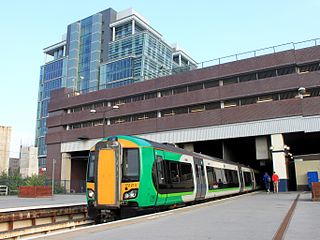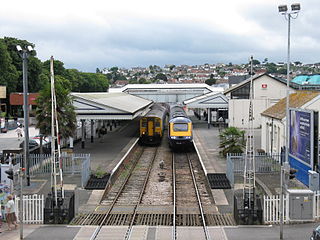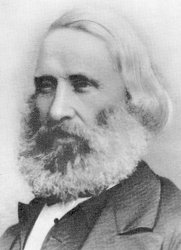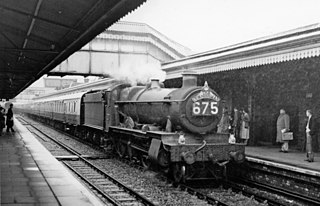
The Great Western Railway (GWR) was a British railway company that linked London with the southwest, west and West Midlands of England and most of Wales. It was founded in 1833, received its enabling act of Parliament on 31 August 1835 and ran its first trains in 1838 with the initial route completed between London and Bristol in 1841. It was engineered by Isambard Kingdom Brunel, who chose a broad gauge of 7 ft —later slightly widened to 7 ft 1⁄4 in —but, from 1854, a series of amalgamations saw it also operate 4 ft 8+1⁄2 in standard-gauge trains; the last broad-gauge services were operated in 1892.

Birmingham Snow Hill, also known as Snow Hill station, is a railway station in Birmingham City Centre. It is one of the three main city-centre stations in Birmingham, along with Birmingham New Street and Birmingham Moor Street.

The 4073 or Castle Class are 4-6-0 steam locomotives of the Great Western Railway, built between 1923 and 1950. They were designed by the railway's Chief Mechanical Engineer, Charles Collett, for working the company's express passenger trains. They could reach speeds of up to 100 mph (160 km/h).

Tyseley Locomotive Works, formerly the Birmingham Railway Museum, is the engineering arm of steam railtour promoter Vintage Trains based in Birmingham, England. It occupies part of the former Great Western Railway's Tyseley depot, built in 1908 to accommodate expanding operations in the West Midlands, particularly the opening of the North Warwickshire Line as a new main line from Birmingham to Bristol.

The Chiltern Main Line is a railway line which links London (Marylebone) and Birmingham on a 112-mile (180 km) route via High Wycombe, Bicester, Banbury, Leamington Spa and Solihull in England.

Newton Abbot railway station serves the market town of Newton Abbot in Devon, England. It is 214 miles 5 chains (345 km) from London Paddington. The station today is managed by Great Western Railway, who provide train services along with CrossCountry.
Wolverhampton railway works was in the city of Wolverhampton in the county of Staffordshire, England. It was almost due north of the city centre, and is commemorated with a small display of level crossing gates and a plaque. Known as the Stafford Road Works, it was opened by the Shrewsbury and Birmingham Railway in 1849 to maintain bought-in locomotives.

The Cambrian Coast Express is an old named passenger train of the Great Western Railway (GWR), and later British Rail, running from London Paddington via Shrewsbury to Aberystwyth and Pwllheli over the Cambrian Line.

Penzance railway station serves the town of Penzance in west Cornwall, England. It is the terminus of the Cornish Main Line and the southernmost railway station in Great Britain, situated at milepost 326.5 miles (525.5 km) from London Paddington. The station is owned by Network Rail and managed by Great Western Railway who also operate train services there, together with CrossCountry.

Paignton railway station serves the town and seaside resort of Paignton in Devon, England. It is 222 miles 12 chains (358 km) from London Paddington, via Box. It opened in 1859 and is now the terminus of Riviera Line services from Exeter and heritage services on the Dartmouth Steam Railway from Kingswear.

Torquay railway station is on the Riviera Line and serves the seaside resort of Torquay, Devon, England. It is 219 miles 79 chains (354 km) from London Paddington.

Plymouth Millbay railway station was the original railway terminus in Plymouth, Devon, England. It was used for passenger trains from 1849 to 1941. It was rebuilt in 1903.

The Great Western Arcade is a covered Grade II listed Victorian shopping arcade lying between Colmore Row and Temple Row in Birmingham City Centre, England.

Joseph Armstrong was an English locomotive engineer and the second locomotive superintendent of the Great Western Railway. His younger brother George and one of his sons also became outstanding engineers in the employment of the GWR.

The Pembroke and Tenby Railway was a locally promoted railway in Pembrokeshire, Wales. It was built by local supporters and opened in 1863. The line, now known as the Pembroke Dock branch line, remains in use at the present day.

The Cornishman was a British express passenger train to Penzance in Cornwall. From its inception in the 19th century until before World War II it originated at London Paddington. Under British Railways the name was applied to a different service, starting variously from Wolverhampton, Leeds or Bradford.
The West London Railway was conceived to link the London and Birmingham Railway and the Great Western Railway with the Kensington Basin of the Kensington Canal, enabling access to and from London docks for the carriage of goods. It opened in 1844 but was not commercially successful.

Great Western Railway accidents include several notable incidents that influenced rail safety in the United Kingdom.

Cheltenham Spa St. James railway station was a station in the town of Cheltenham.
The Birmingham, Wolverhampton and Dudley Railway was an English railway company promoted to connect those places by rail. It was authorised by Parliament in 1846. It became apparent that it would be advantageous to merge with the Great Western Railway. The rival London and North Western Railway went to great lengths to frustrate the amalgamation, but ultimately failed, and the merger took place in 1847.




























